The annual debacle around Marcelo Bielsa and his expiring contract has begun. It is something that the Leeds United board have involuntarily become used to since his arrival at the Yorkshire club in 2018. When questioned in the last month about his current contract situation, his repeated response was that he wants the get the games out of the way first – even with Leeds’ Premier League status secured for next season.
Although it is to be believed that he will eventually sign a new deal – Bielsa is the master of surprises; everything is on his terms and nothing less. If he were to leave, one of the leading candidates to replace him is the departing Roma manager, Paulo Fonseca, formerly of Shakhtar Donetsk, Braga, Pacos de Ferreira, and Porto. This analysis will explore his philosophy and suitability to the Peacocks.
In this tactical analysis, we will evaluate what went right and wrong at Roma, how transferable his tactics are to Leeds, and who some of the key men could be.
Defensive setup & formation selection
In his first season at the club, Fonseca utilised a 4-2-3-1 formation for the most part in domestic play, successfully guiding them to 5th place, earning their spot in Europa League football. A switch to a 3-4-2-1 in their 2-1 victory over Parma with eight games left to play in the league saw Roma win seven and draw once, to solidify a wonderful conclusion to the season. This would continue into next season, primarily utilising a 3-4-2-1, however, in recent weeks he has chosen a 4-2-3-1 again.
The change formation did not actually oversee too many selection changes, Fonseca rather changed the positions of some of his key players instead. Most noticeably, Bryan Cristante has transformed into a centre-back this season, moving into the middle of a back three, changing his role into the often-labelled ‘libero’ – a versatile centre-back who ‘sweeps up’ the ball and actively engages his opponents by stepping out of his line. It is a change that has provided the team with enhanced passing options.
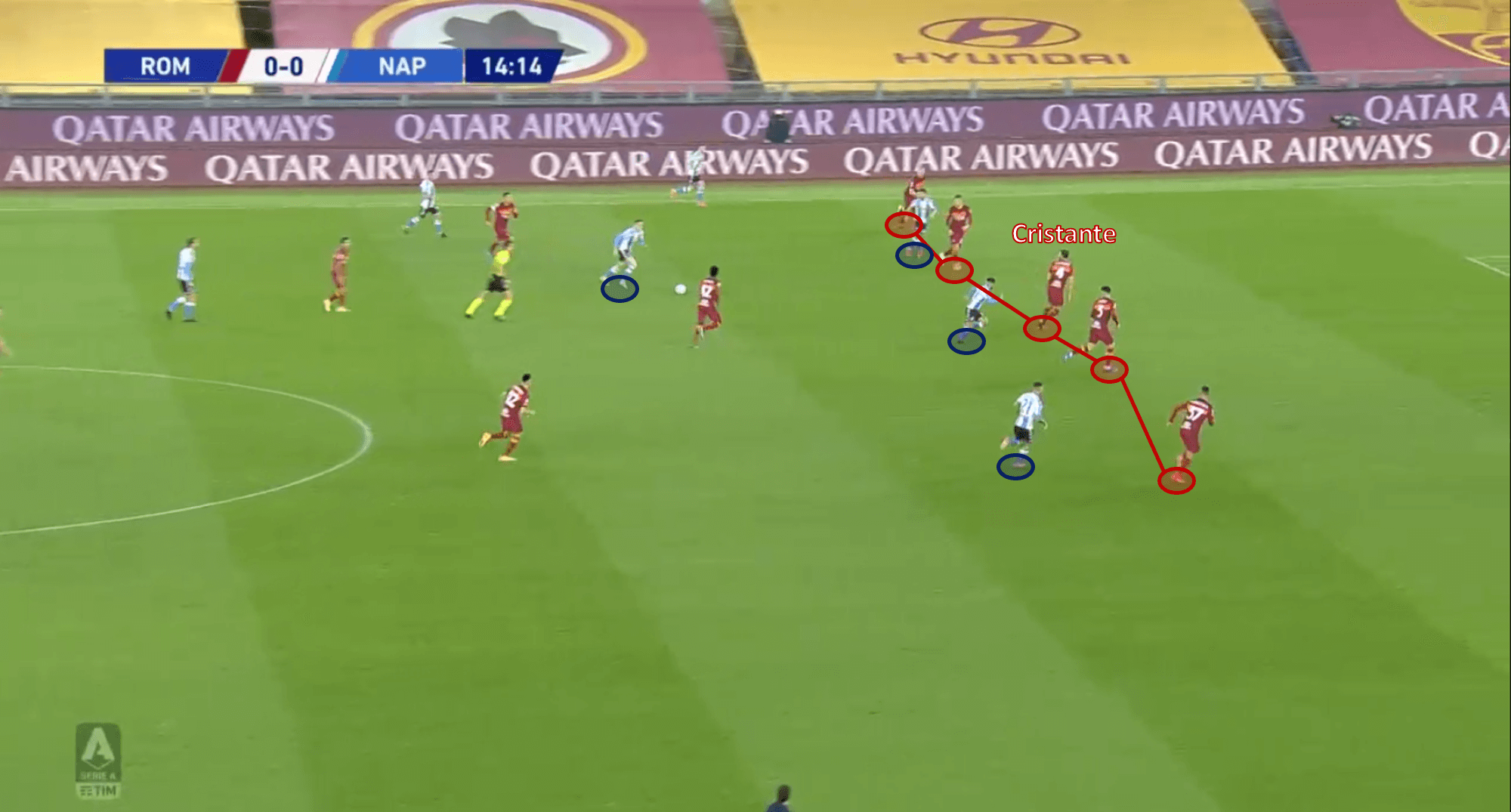
At the core of the defence – Cristante anchors a back five in transition with the wing-backs tucking inside.
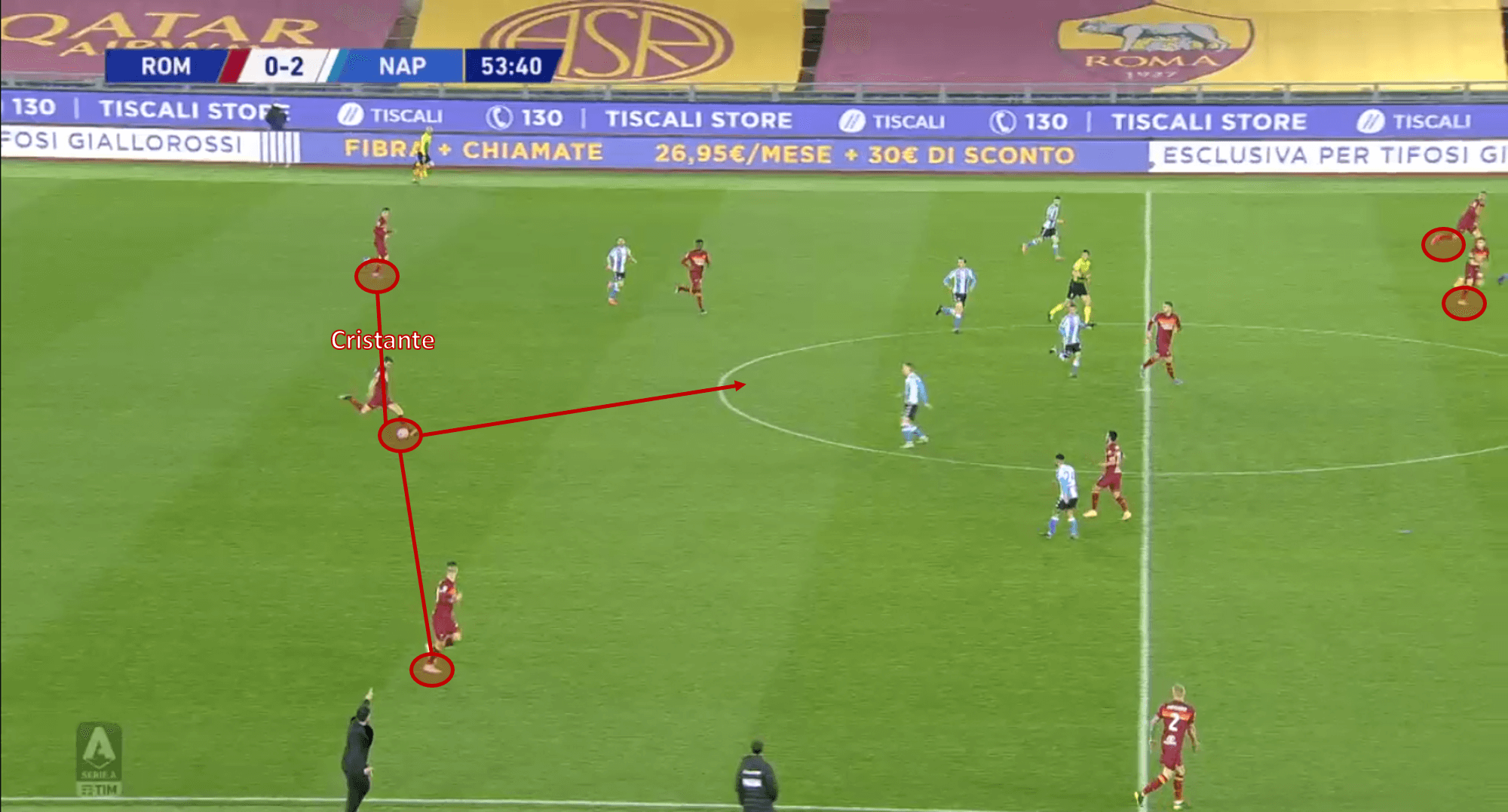
Cristante here spots the runs of Leonardo Spinazzola and Stephan El Shaarawy – the latter of which he finds with a long-range pass.
Against sides which Roma expect to win against, Cristante pushes up into the midfield to give them greater control over these weaker sides. At Leeds, the obvious candidate to act in this role would be Kalvin Phillips. He is tactically intelligent, possesses the passing range of a Cristante, but at just 5’9” with an aerial duel success rate of just 46%, he may not be entirely suitable in the role long-term, not at least without serious aerial protection. For Cristante, 6’1”, this was less of an obvious issue.
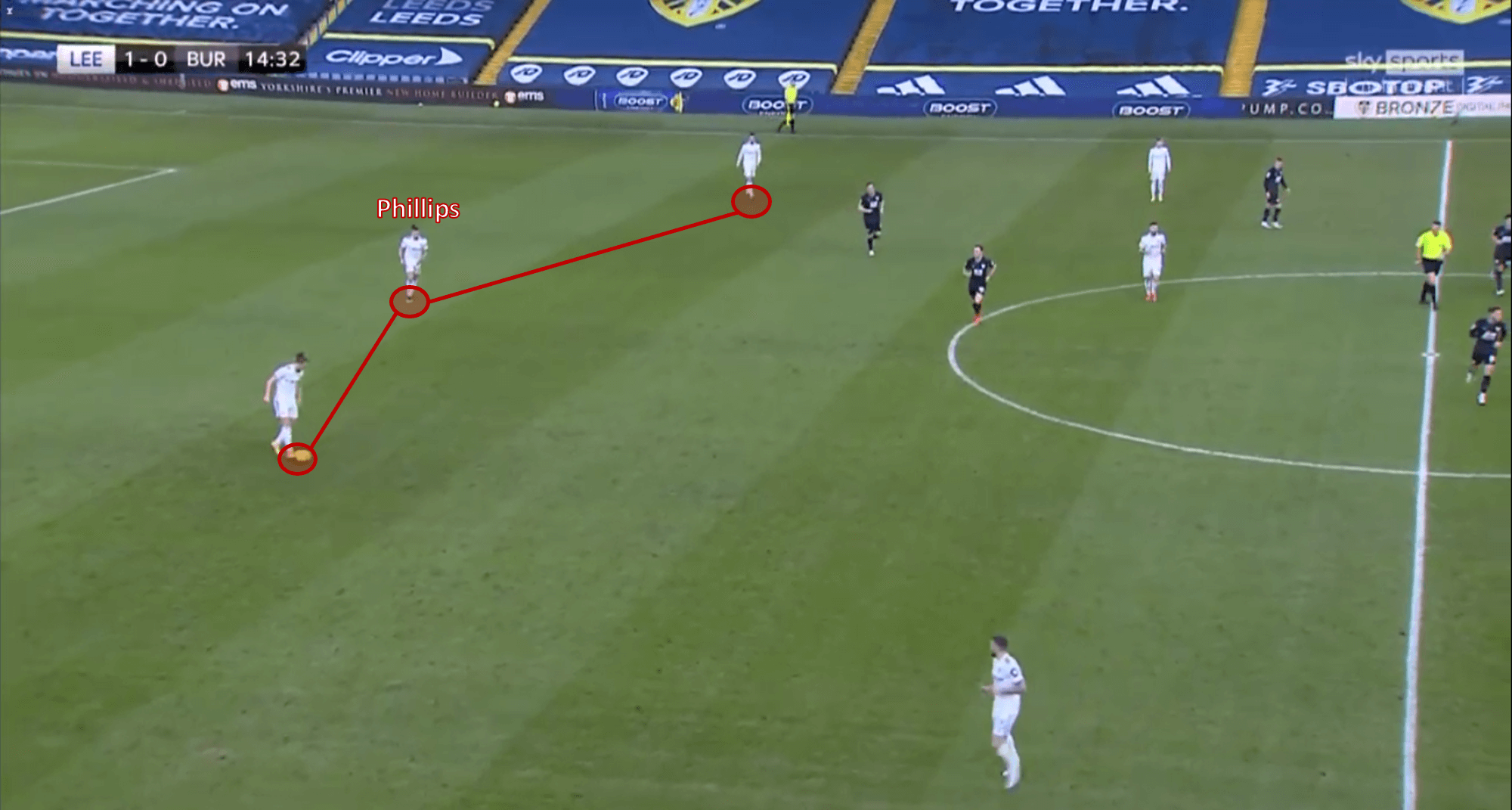
Against Burnley, Phillips actually started and played as a centre-back for the full ninety minutes; a game they won 1-0.
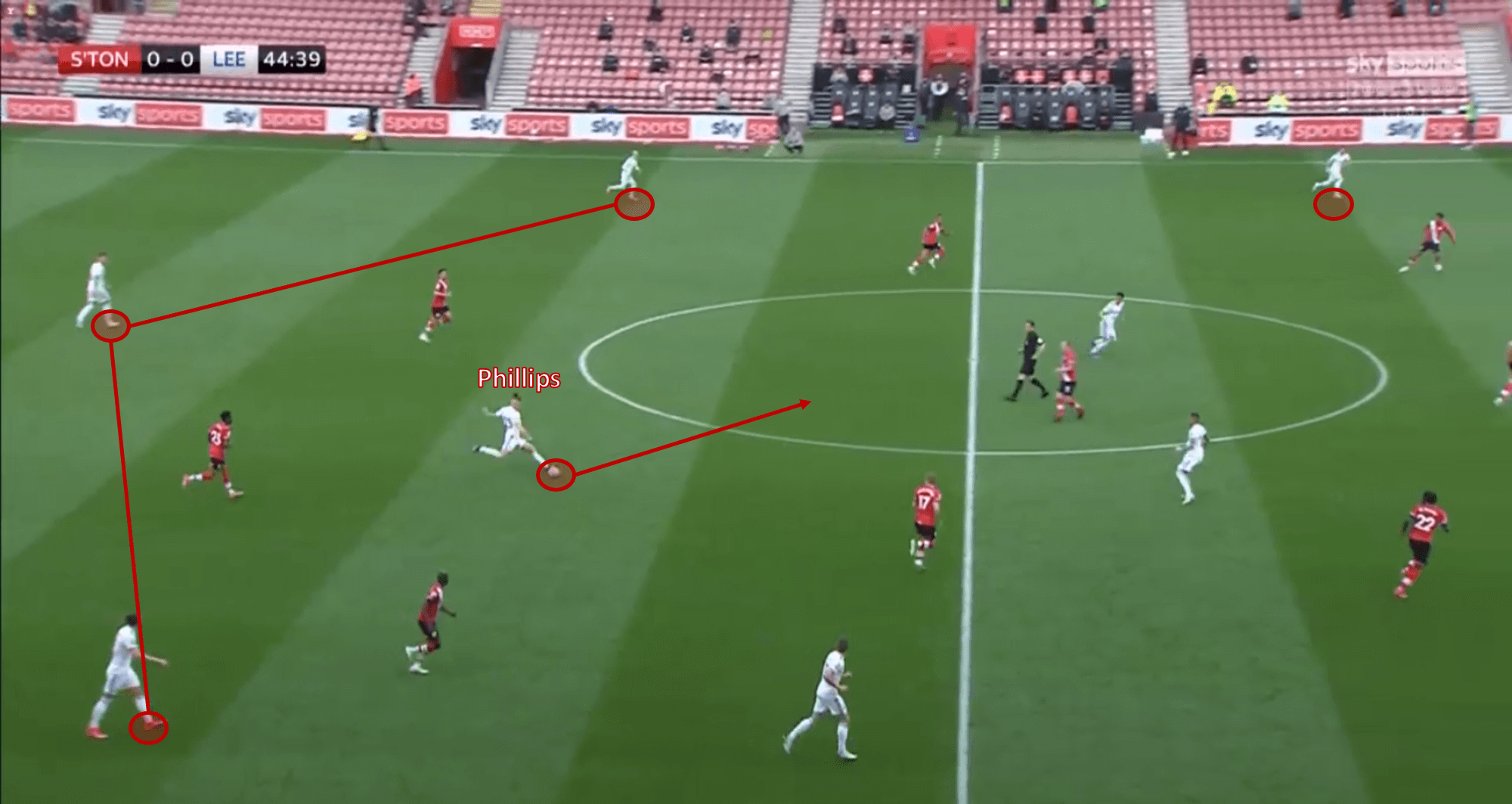
Sitting in front of the back three, Phillips distributes out wide-left to Harrison making a run beyond the defensive line.
It was clear that Fonseca heavily favoured defenders who were comfortable with the ball at their feet – intelligent ones at that too. Ibañez, Marash Kumbulla, and Gianluca Mancini gave the Portuguese coach considerable depth alongside former Manchester United defender Chris Smalling who featured less so this season with that heavy emphasis on ball progression from the backline.
At Leeds, Fonseca would also have a plethora of defenders who can put a shift in at centre-back, who also possess good ball-playing abilities in Diego Llorente, Robin Koch, Luke Ayling, Liam Cooper, and others. Bielsa’s multi-positional play would leave them in good stead under Fonseca, who has also tinkered around with an individual’s starting position, such as Cristante.
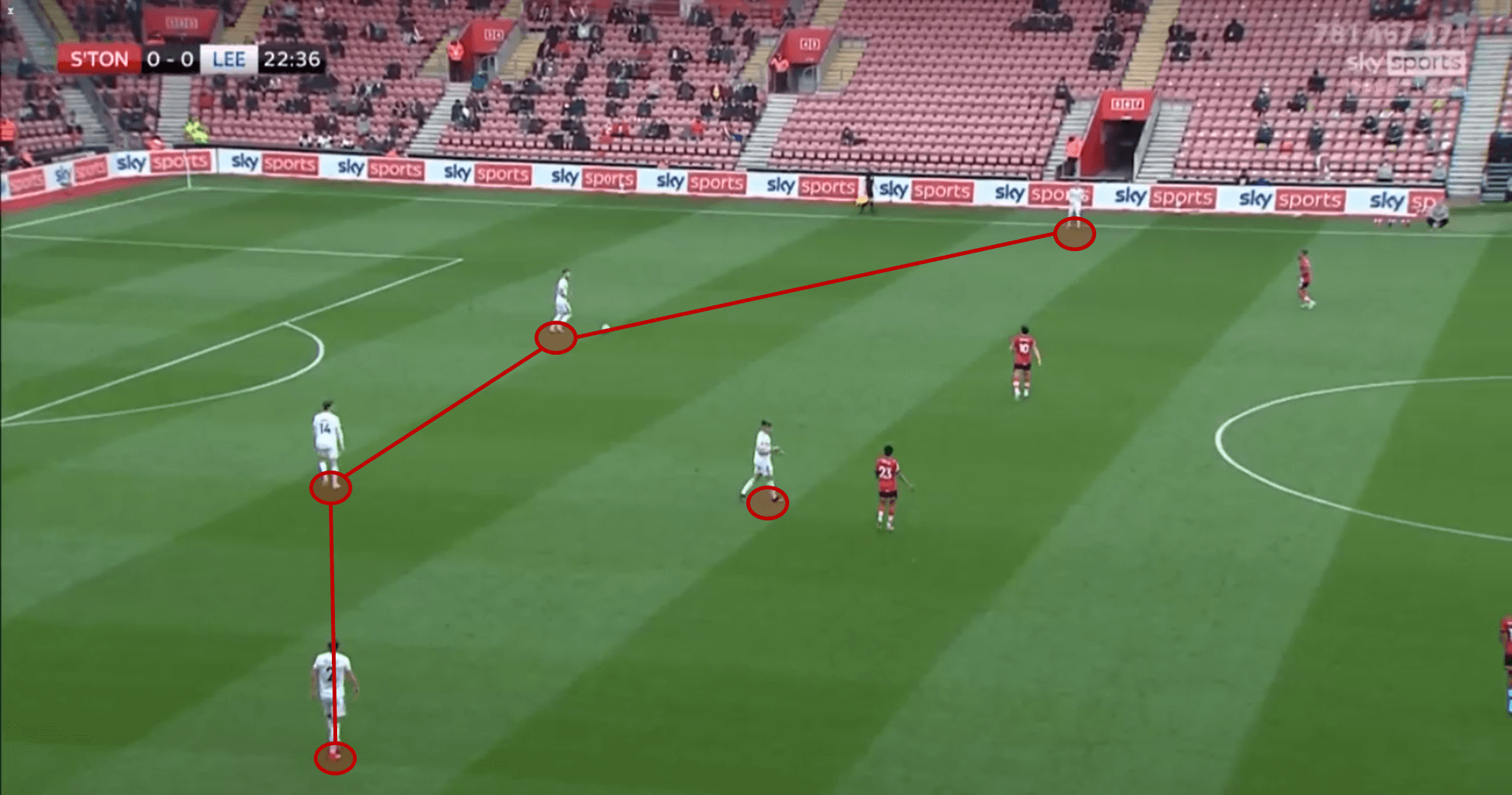
Bielsa’s back four can transition into a back three swiftly if Ayling drops slightly deeper and allows Alioski on the other side to push forward.
To facilitate this build-up, one full-back joins the midfield, and the opposite side winger coming deeper to offer protection. In a more natural 3-4-2-1, both of Roma’s wing-backs remain higher up the pitch, making the preferred selection of Leonardo Spinazzola and Rick Karsdorp more understandable from a tactical perspective.
In the early stages of build-up as well, the back three splits wide, which permits Pau Lopez to move up and make the shape look like a flat back four, instead of a back three. On occasion, the left or right-sided centre-back will push even wider to facilitate another midfielder dropping deep to pick up the ball and play short-passing interchanges to progress up the field. Mancini and Ibañez often find themselves very wide in the early stages of build-up, circulating the ball from left to right until the right passing angle arrives.
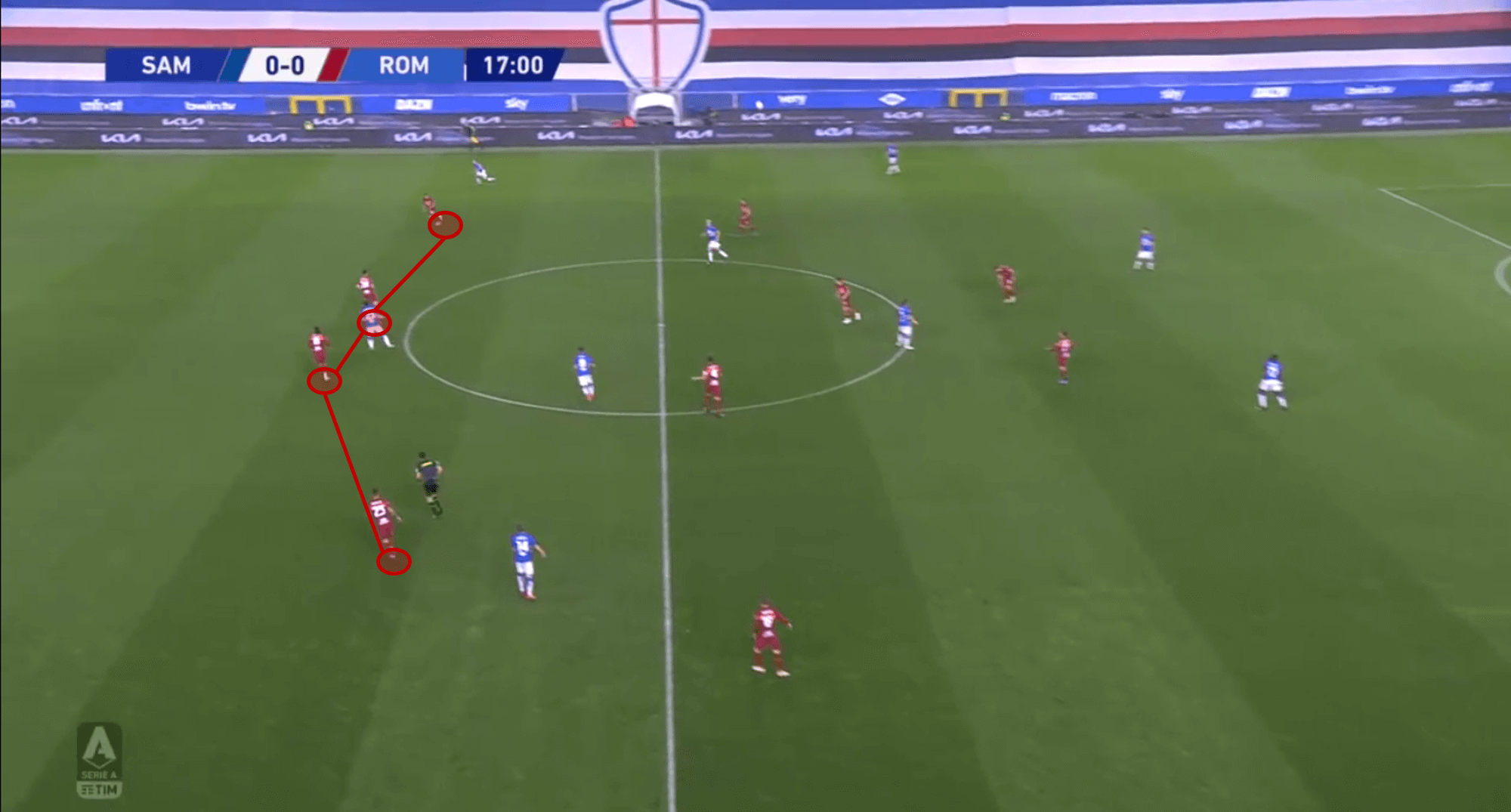
Roma under Fonseca are tactically flexible; Bruno Peres at left wing-back drops deeper to track the runner, whilst Davide Santon on the right remains high as a back four is already in place.
Short-passing transitional play
Fonseca favours short passing out of defence, with midfield players positioning themselves in between the lines to receive the ball and aid ball progression. Similarly, to Bielsa’s Leeds, Roma have not tended to pass long and direct, despite having a physically imposing focal point in the form of Edin Džeko. If they do pass long, it is usually to exploit the high line of the better sides in the division.
It suited Roma this season, to an extent, with highly technical players who are adept at finding space in the final third, ala Lorenzo Pellegrini, Henrikh Mkhitaryan, and Pedro. They have favoured a slower pace in build-up, attempting to wear out pressing opponents in an attempt to exploit open gaps in the opposition defensive structure.
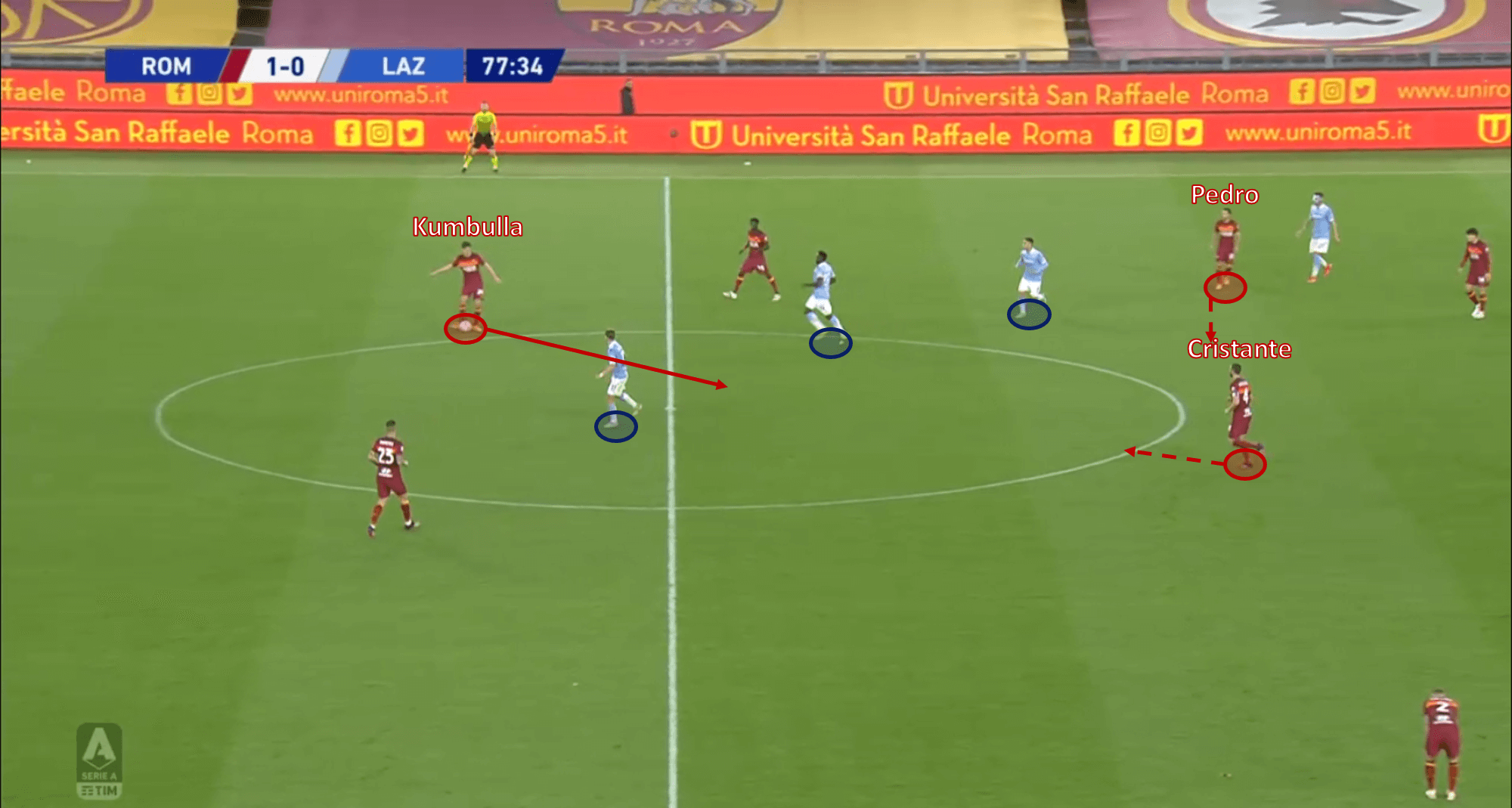
Down the central channel, Kumbulla plays the progressive pass into Cristante while Pedro moves infield.
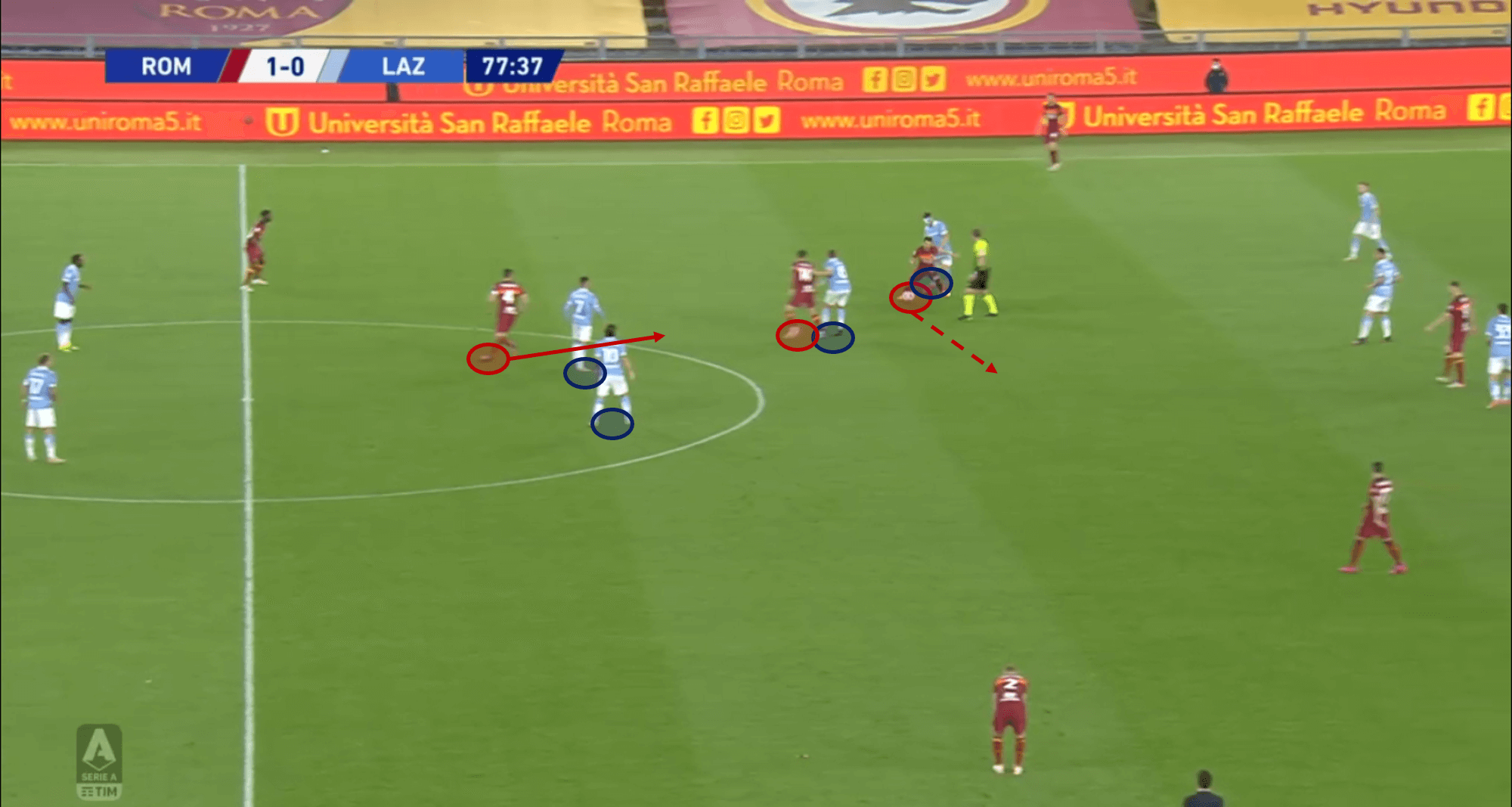
Cristante immediately lays off the ball towards Pedro, who collects the ball and bursts into plenty of green space ahead.
Jordan Veretout, a high-scoring central-midfielder, has also been crucial to this build-up play. He offers a similar range of passing to Cristante, and when he drops into space to receive the ball, he can use his vision and passing ability to find one of Roma’s forwards who have ventured into space between the lines. All the while making late runs into the box to score a good portion of goals.
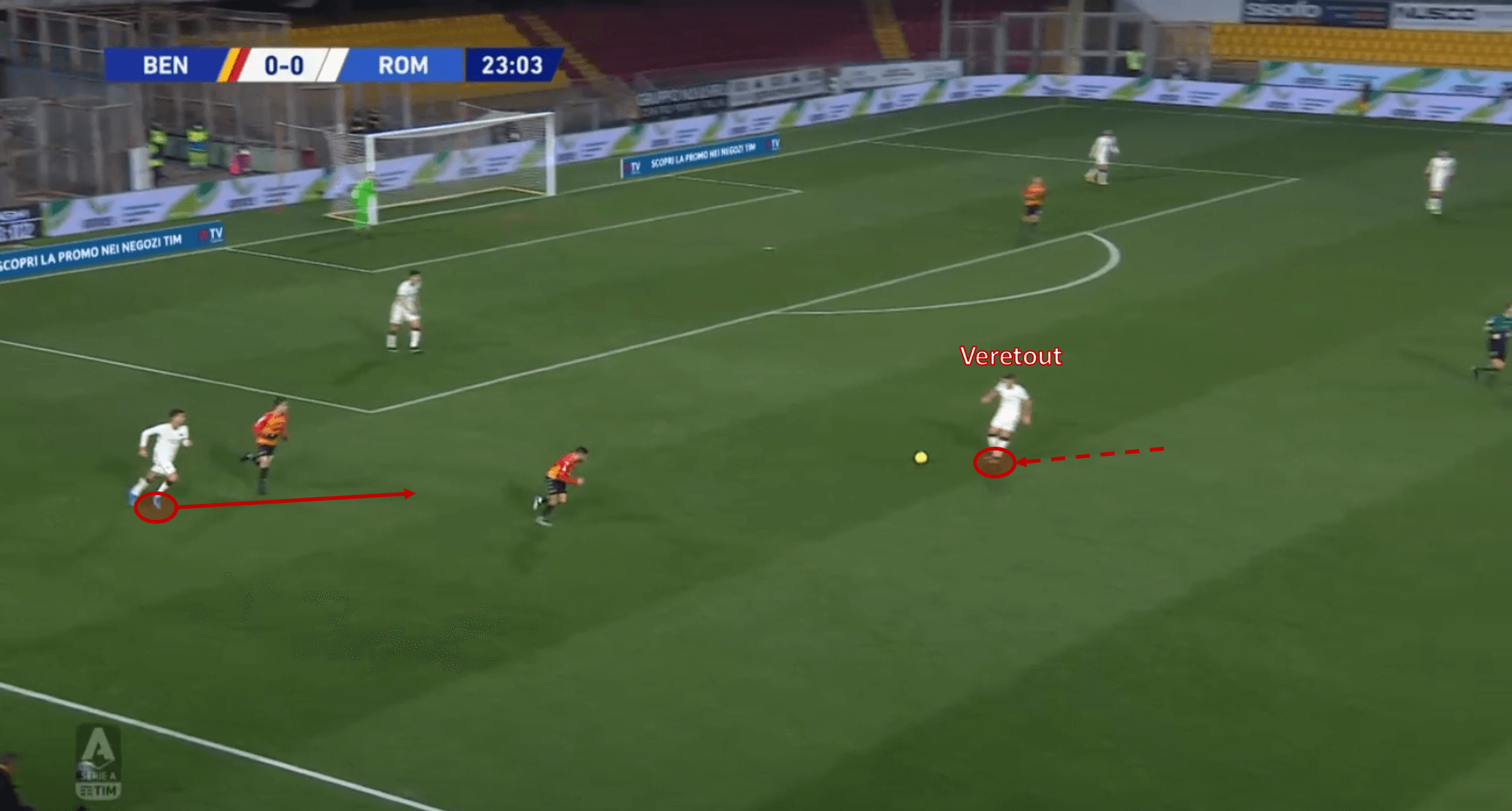
Veretout drops deep here to collect the ball and aid ball progression against Benevento.
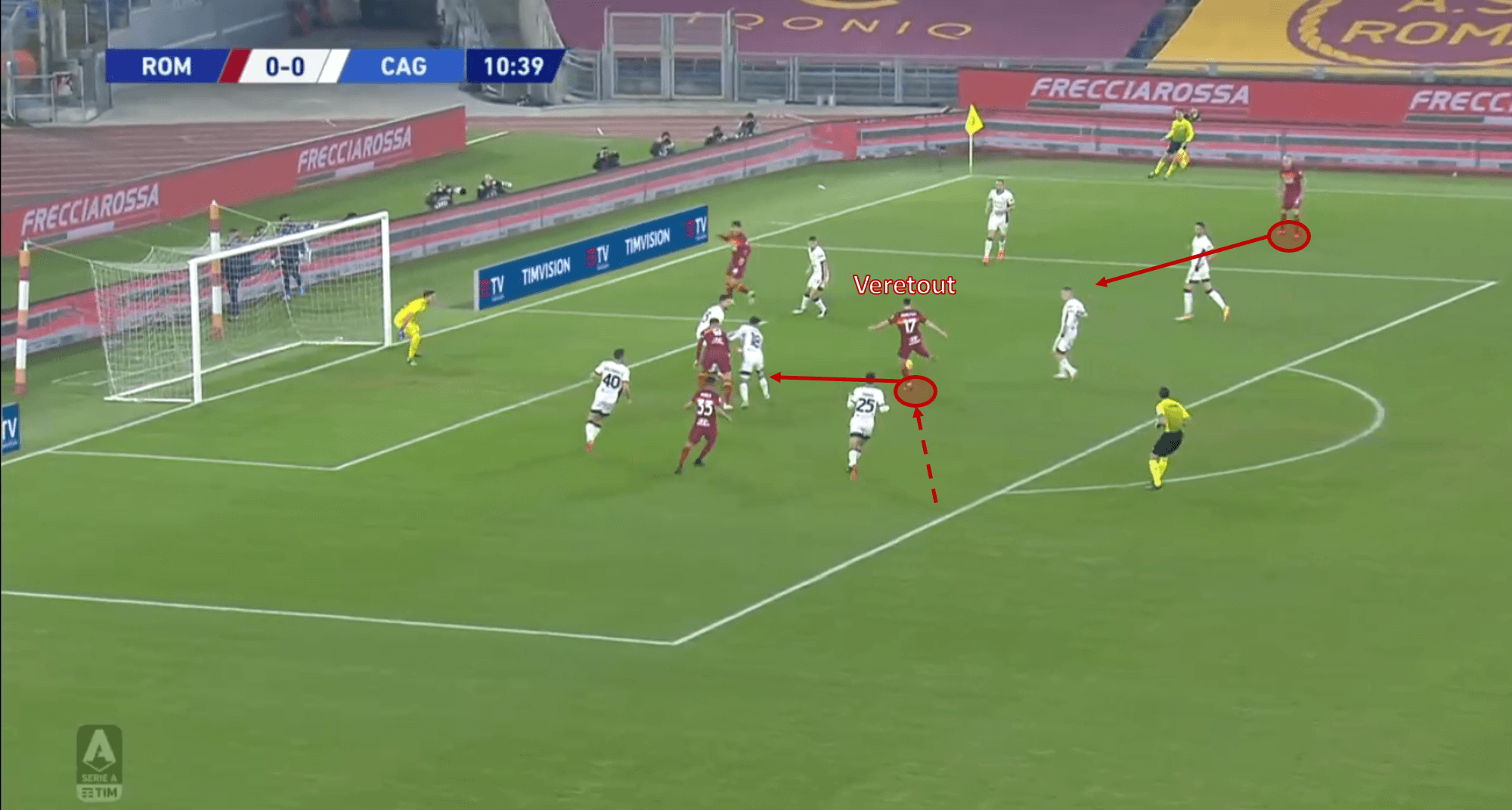
Running from left to right, Veretout blindsides the Cagliari defence after a deflected cross from the right-wing.
Stuart Dallas at Leeds has played a comparable-ish role to the Frenchman this term under Bielsa, impressing with his goalscoring numbers as well. Dallas, during the course of just ninety minutes, can play in several positions, but most frequently shifting between left-back and central-midfield to assist Leeds’ transition from a 4-1-4-1 to Bielsa’s classic 3-3-1-3.
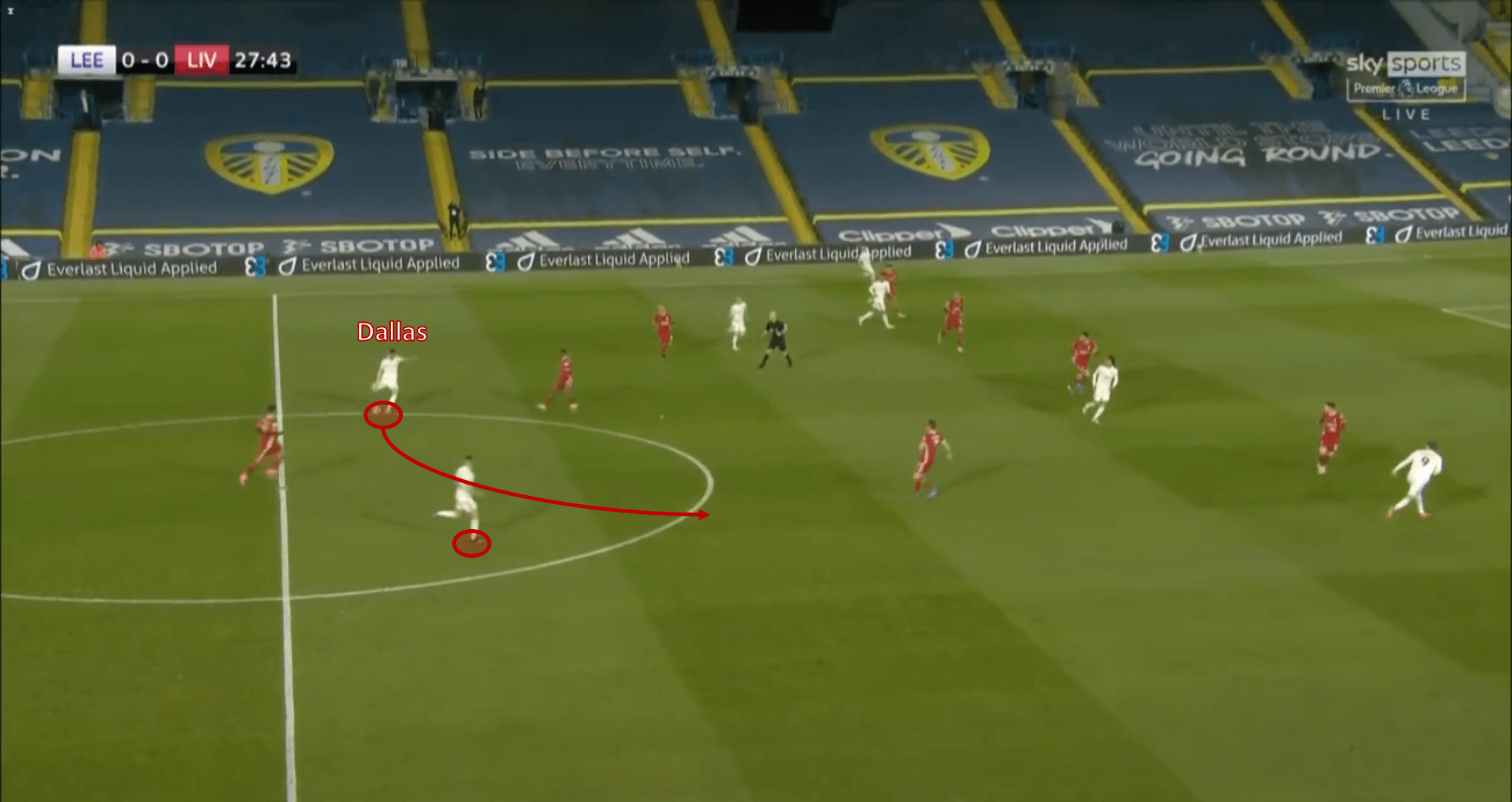
Dallas here receives the ball deep in the build-up and plays the rangy pass out towards the right-wing.
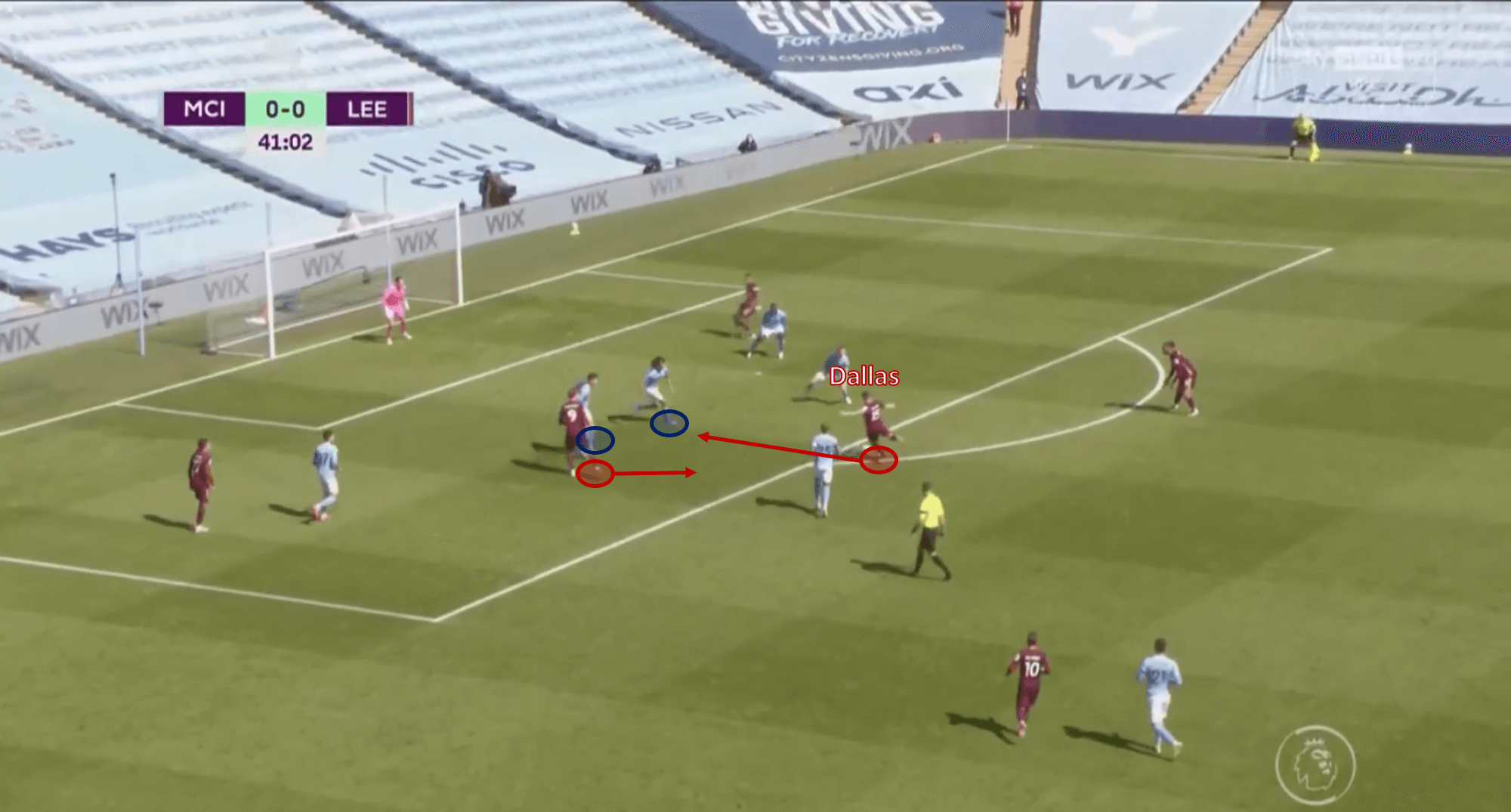
Dallas’ late run is met by Patrick Bamford, and the Northern Irishman slots the ball into the bottom-left for one of his two match-winning goals against champions Man City.
Under Fonseca, Roma have also looked to attack down the middle more so than any other side in Serie A. 31% of their time is spent down the middle of the pitch, with the inverted-wingers spending a lot of their time on the pitch in central channels, helping to create overloads in these areas when possible. These wingers play very close to the striker, which we will cover in more detail later on in the piece.
While Roma are first in Serie for their time spent down the middle of the pitch, Leeds stand 16th in the same statistics in the Premier League, only attacking 24% of the time down the same area. In fact, much of their ball progression has come from their full-backs, but specifically Luke Ayling, who has been fantastic with his long-range passing and ball-carrying abilities.
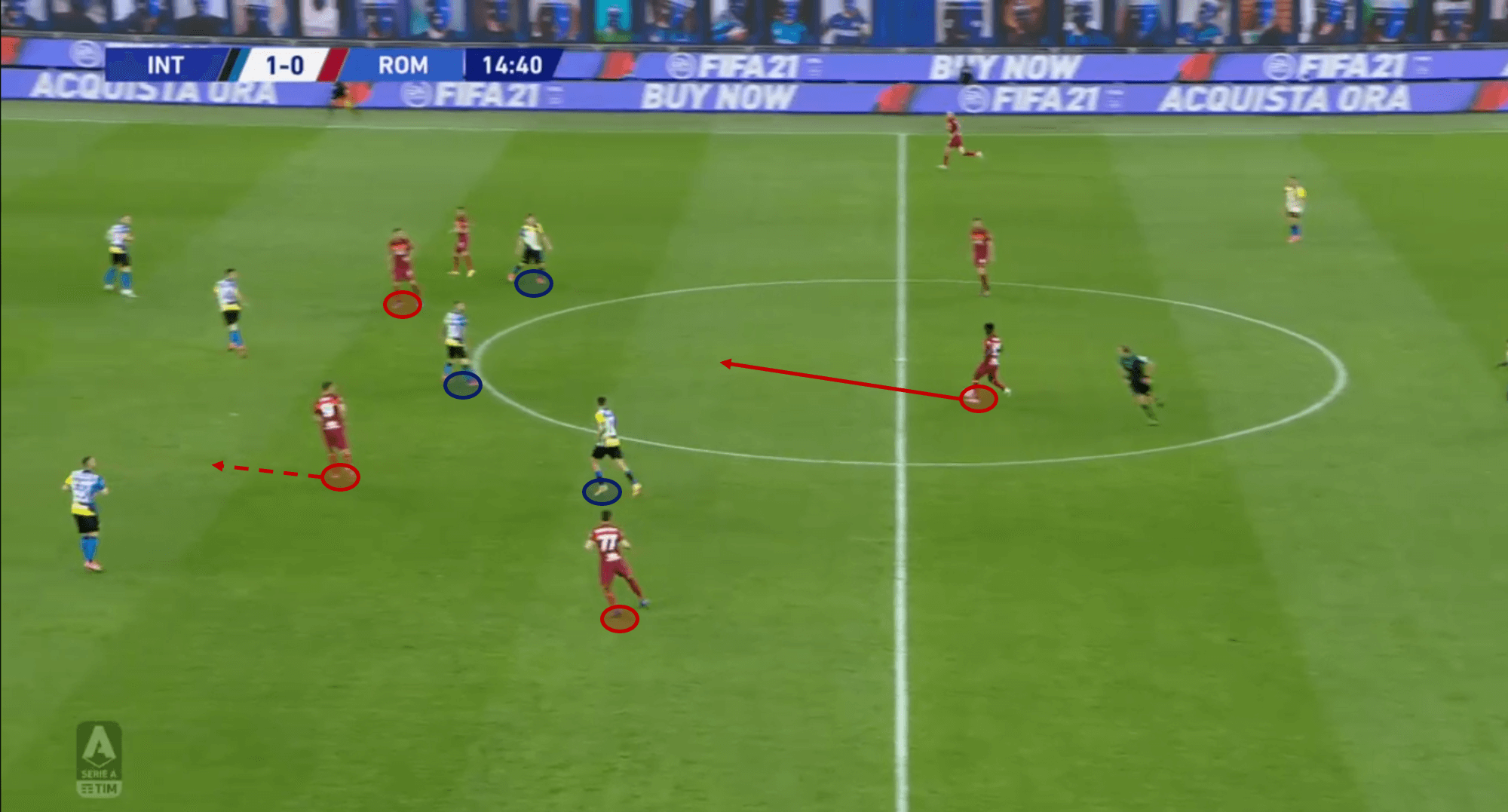
Ebrima Darboe plays the vertical pass forward with a few forwards ready to complete their attacking rotations, couple of runners and a couple of passers.
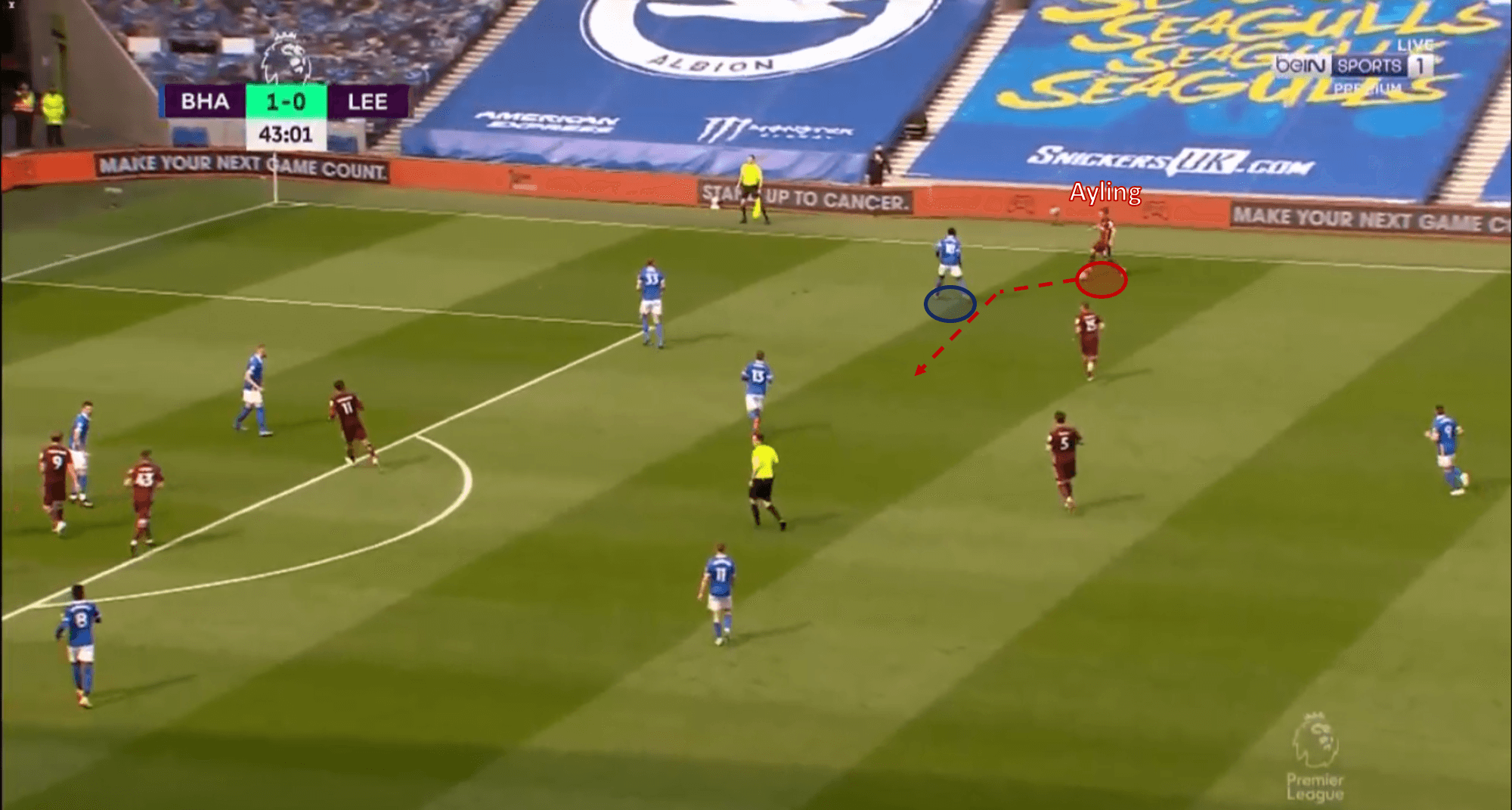
Ayling high up the pitch is preparing to take on Bissouma 1v1, driving inside to force an attack for Leeds.
It is a tactical shift that Leeds would have to become accustomed to under Fonseca. Bielsa does like to stretch the pitch as much as he can, and this has left his side to be susceptible at times, but it has also allowed his team to generate a high volume of shooting opportunities that would not present themselves otherwise. With Fonseca, it is a much more conservative focus.
Attacking rotations & pressing from the front
As mentioned previously, the inverted-wingers cut inside when Roma have possession of the ball, while the wing-backs overlap to occupy the vacant wide zones. Džeko is a really useful focal point to have when utilising a narrow front three thanks to his ability to hold up the ball and lay it off at the right moment, which he has become superb at.
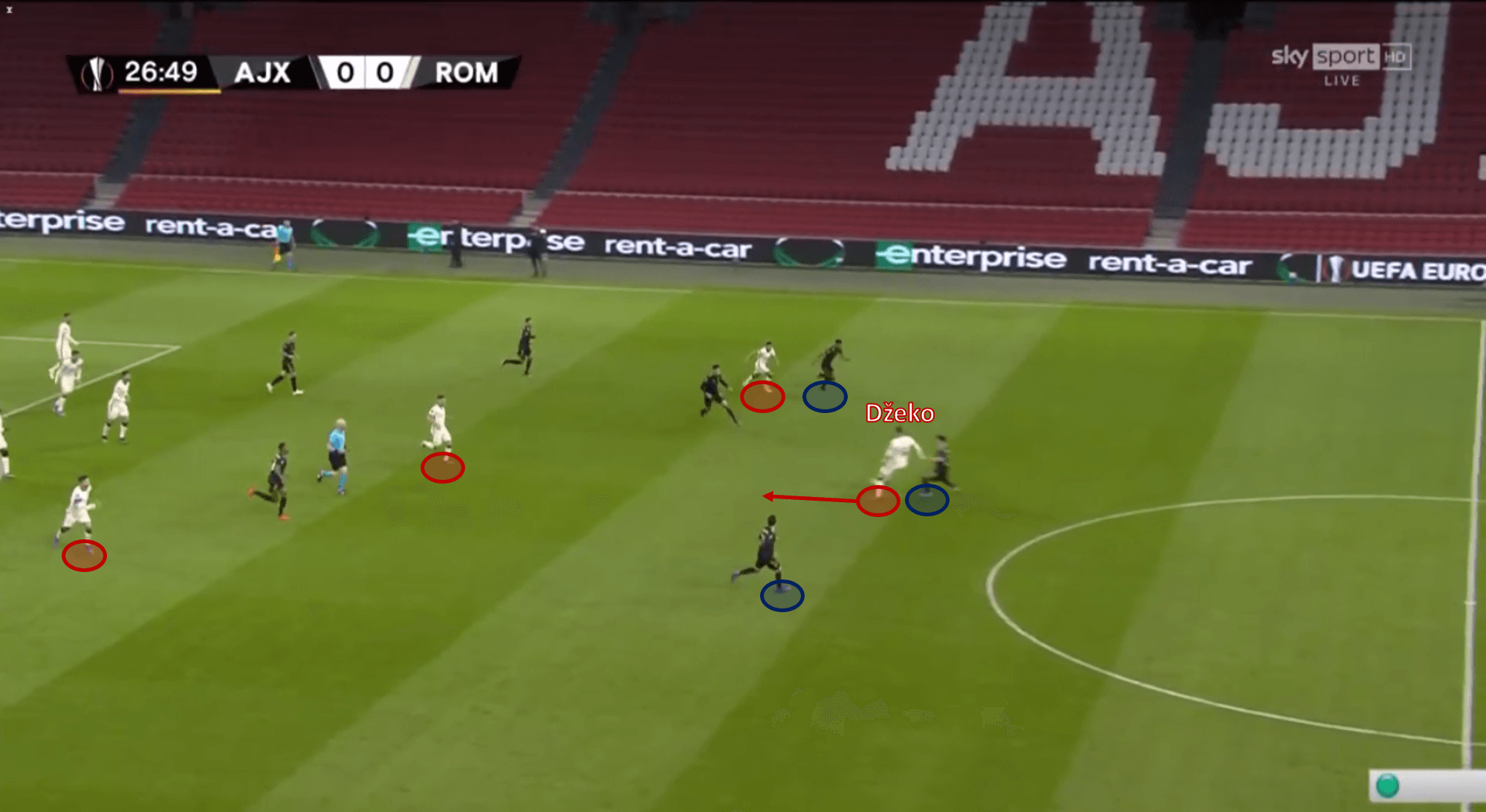
Džeko holds up the defender, fending off the pressure, and lays off the ball to a Roma teammate, assisting the pace of the counterattack.
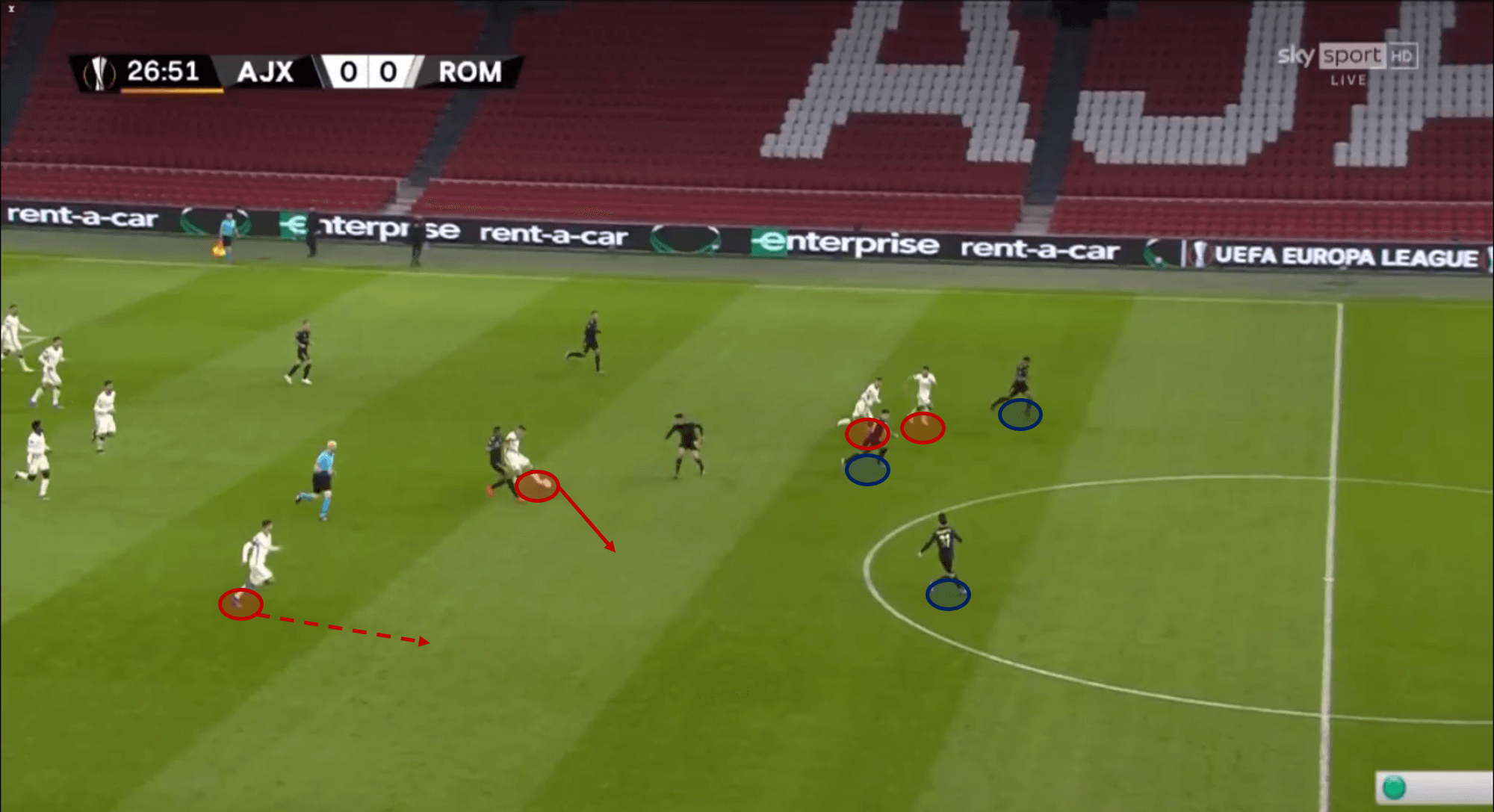
With Roma players hitting Ajax on the break, Džeko spins his man and acts as another runner.
This is, in part, what has helped Veretout experience the goalscoring success he has this season – an unexpected late runner from deep which is difficult to defend against when you have three forwards and two overlapping wing-backs to deal with as well. His ten goals in the league is the greatest return of any central-midfielder in Serie A, and Dallas, as mentioned, could benefit from this if Fonseca were to join Leeds.
Behind Džeko, the experienced attackers Mkhitaryan and Pedro buzz around, aim to find passing lanes into the box or take a shot on goal themselves. Mkhitaryan, at times, during matches has acted as an off-centred #10 behind Džeko and Pedro who will consistently ask questions of the defence with his insistent runs beyond the defensive line.
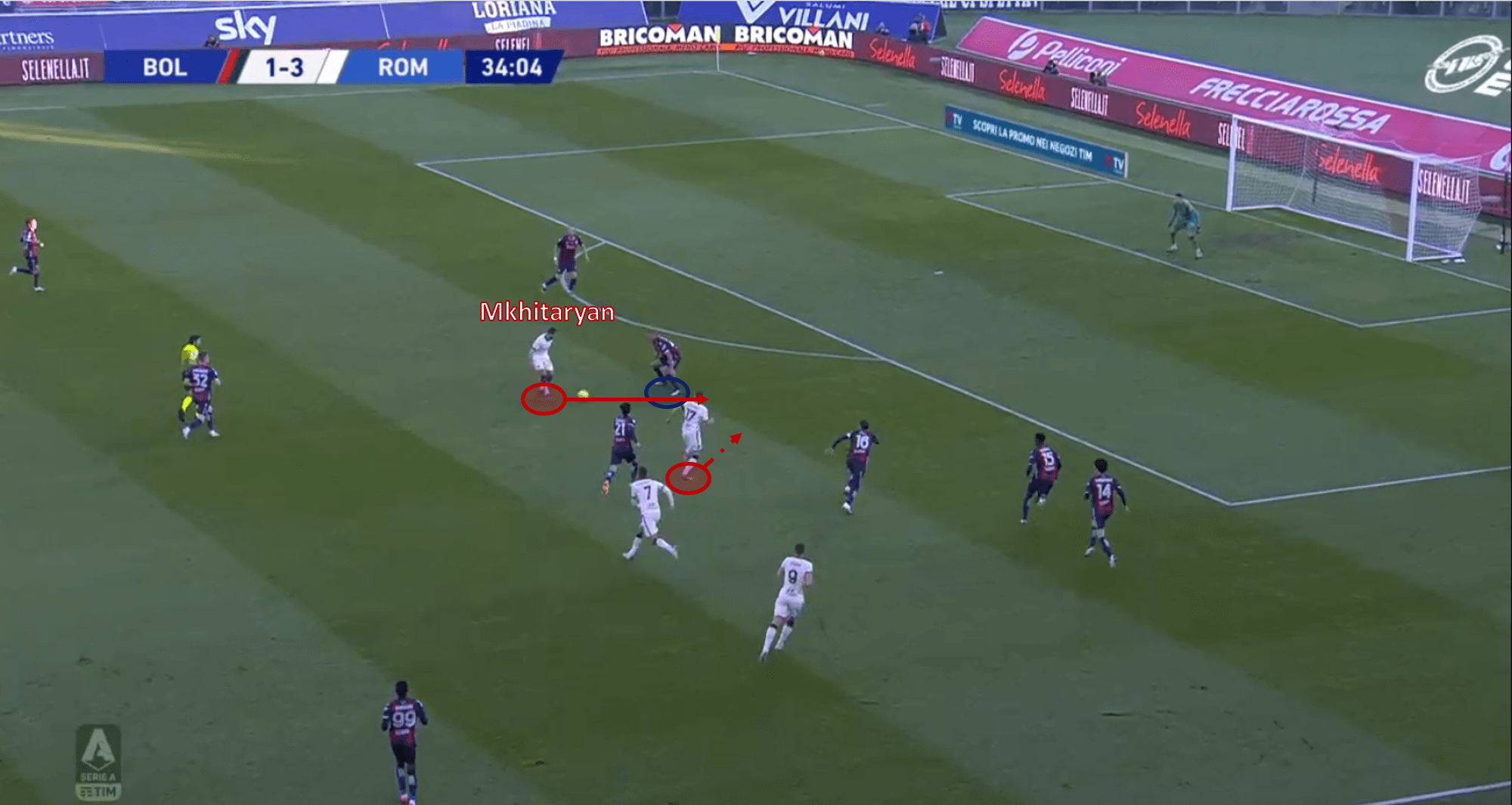
Mkhitaryan places himself in a central position to play the through pass, penetrating the Bologna defence.
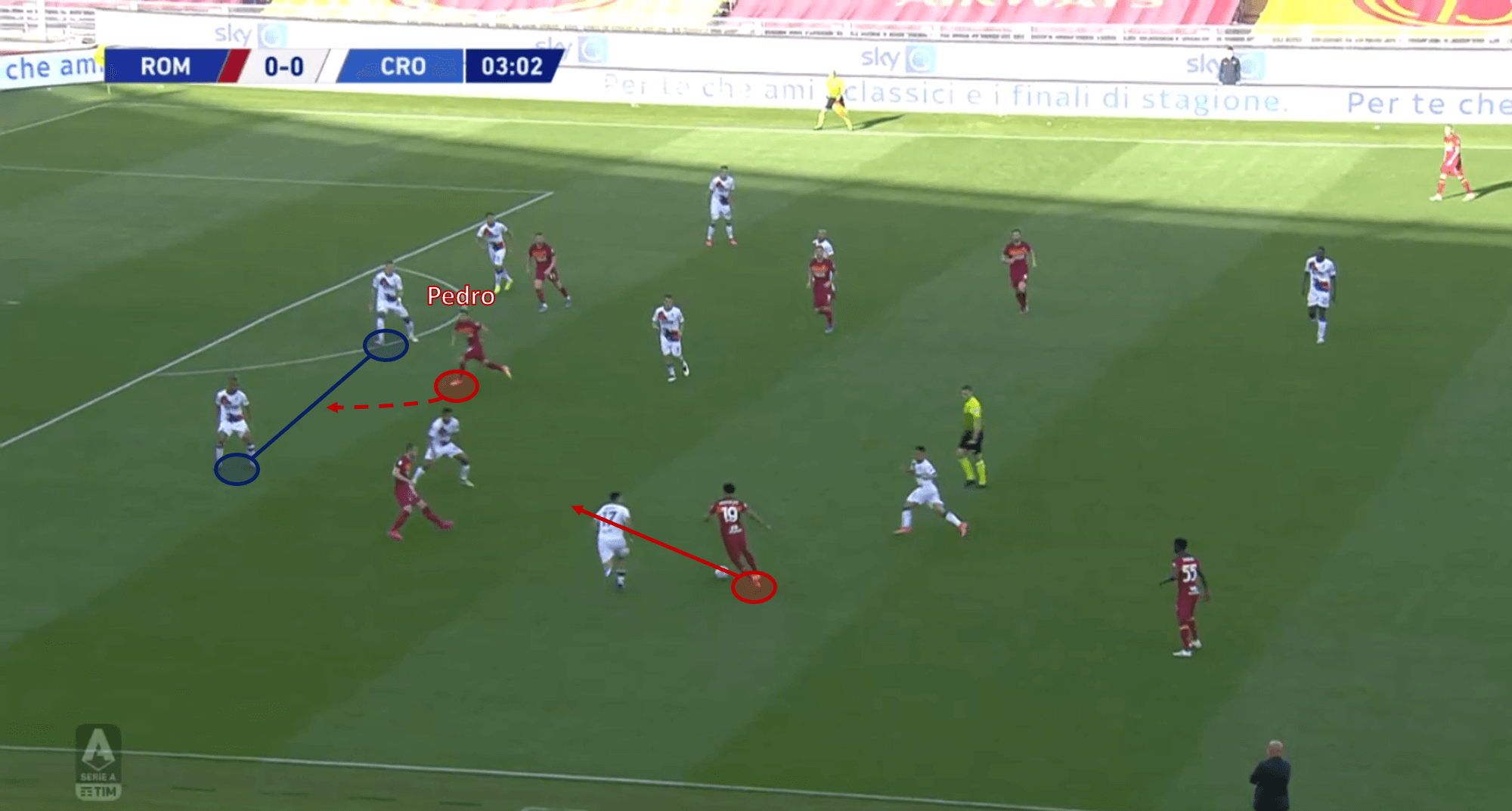
Bryan Reynolds spots the run by Pedro – who is making one of his most consistent bursts between the full-back and centre-back.
This is very possible to imagine at Leeds, with each winger reversing the roles. Instead of Mkhitaryan on the left, Raphinha on the right could cut inside the operate behind Patrick Bamford, while Jack Harrison on the left could hang on the last shoulder of his opponent and look to run into the box from a wide-angle as often as possible. With Raphinha’s strong creative abilities and Harrison’s willingness to run and score goals, this is a potential option.
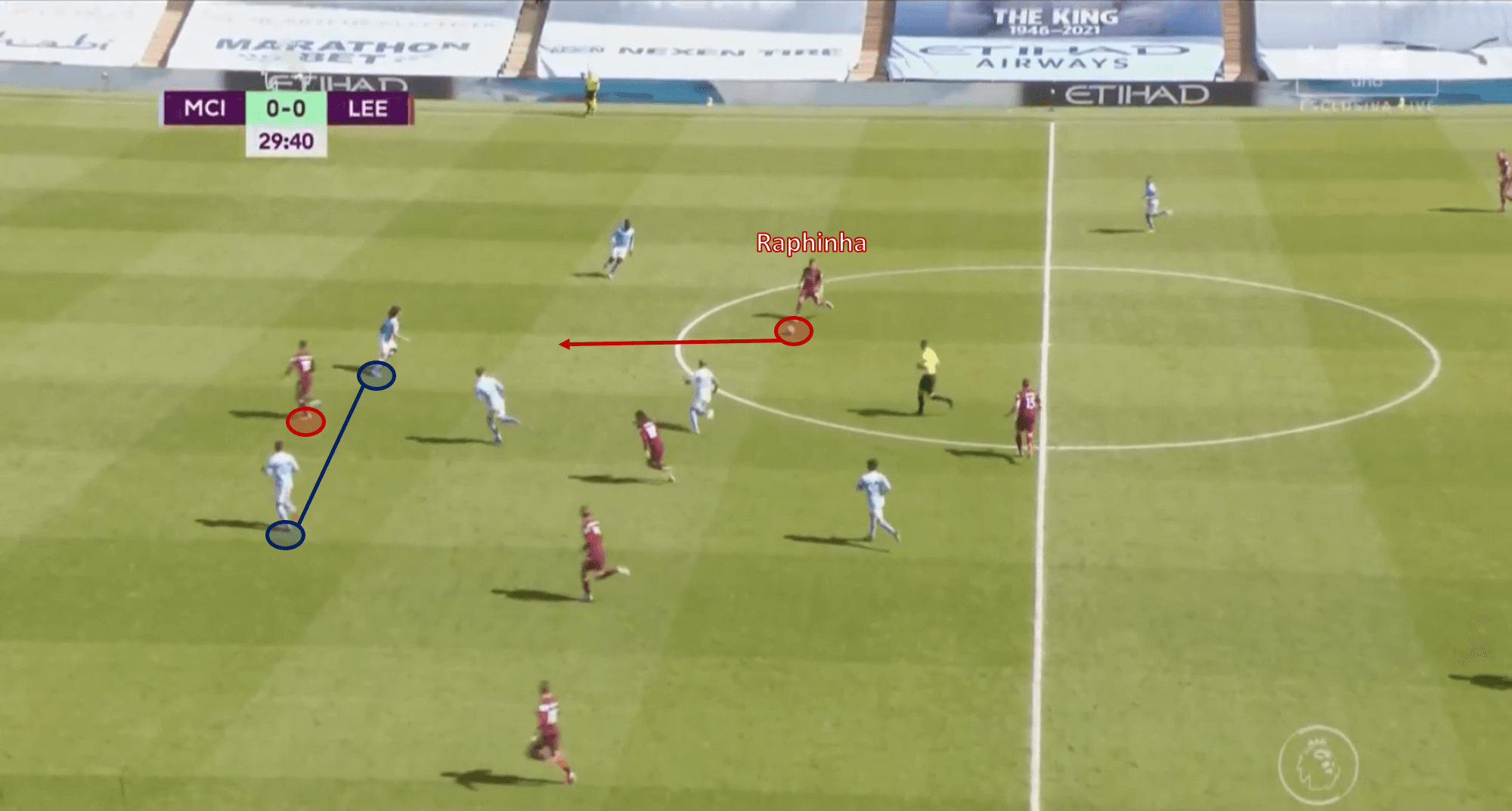
Raphinha here in a central area – which is rare it must be said – spots Roberts run a touch too late as he is offside, but the vision to spot the run is there.
It is a fluid attack that is reliant on the dynamic movement of its attackers and the potential for the midfielders beneath them to spot their runs in behind. If Leeds were to finally finalise a deal for Rodrigo De Paul, coming off the back of his best season with Udinese, a season where he should rightly be named the best midfielder in the vision, Leeds under Fonseca could find their attacking verve quickly.
Now, one of the most identifiable traits of Bielsa side is in their aggressive pressing. It could be argued that the Premier League has never witnessed a more intense pressing unit than Leeds in its entire history. All over the pitch, Bielsa employs man-marking principles, with a few other players cutting off passing lanes to the player on the ball. It is a high-risk high-reward style of play which they have reaped the benefits of this season.
Roma under Fonseca pressed far less, ranking 7th in Serie A for the number of times they applied pressure, while Leeds over course top the Premier League in this regard, by some margin. Now, this might have something to do with the fact that Roma’s forward line’s combined age is 80-years-old, not allowing them to press with as much intensity. But it is true, overall Fonseca does not employ a high press, and it is something the Leeds players would take time to adapt to.
Final verdict
Time will only tell if Bielsa puts pen to paper for a new deal at Elland Road, but until then, it is fun to ideate with the notion that if he were to be replaced, who would be most suitable? Fonseca would certainly make for a fitting candidate in my eyes. There are a few similarities in the two sides style of play, although some adaptation would be required, he would be a better fit than the likes of Julen Lopetegui or Steven Gerrard, at least stylistically.





Comments